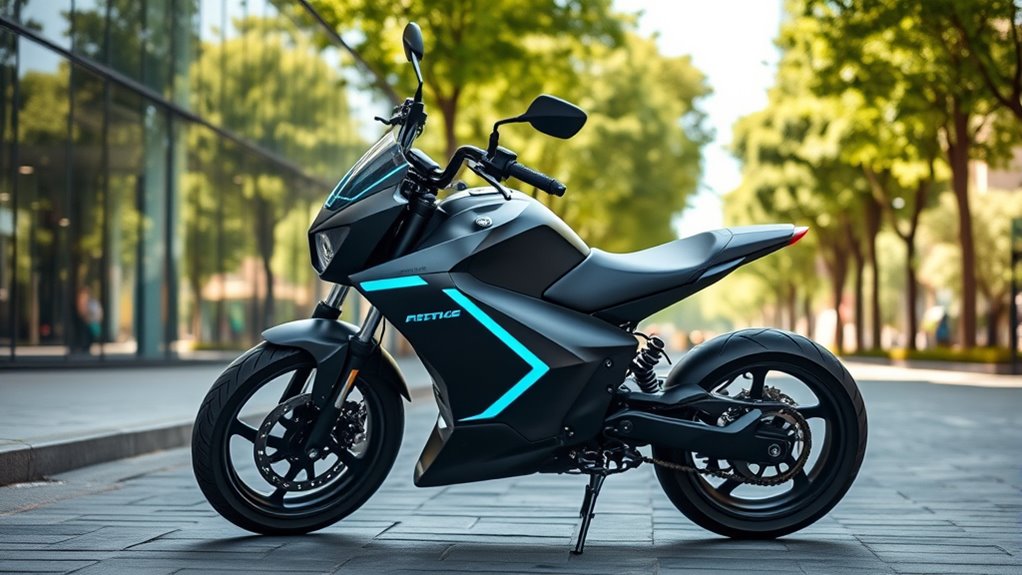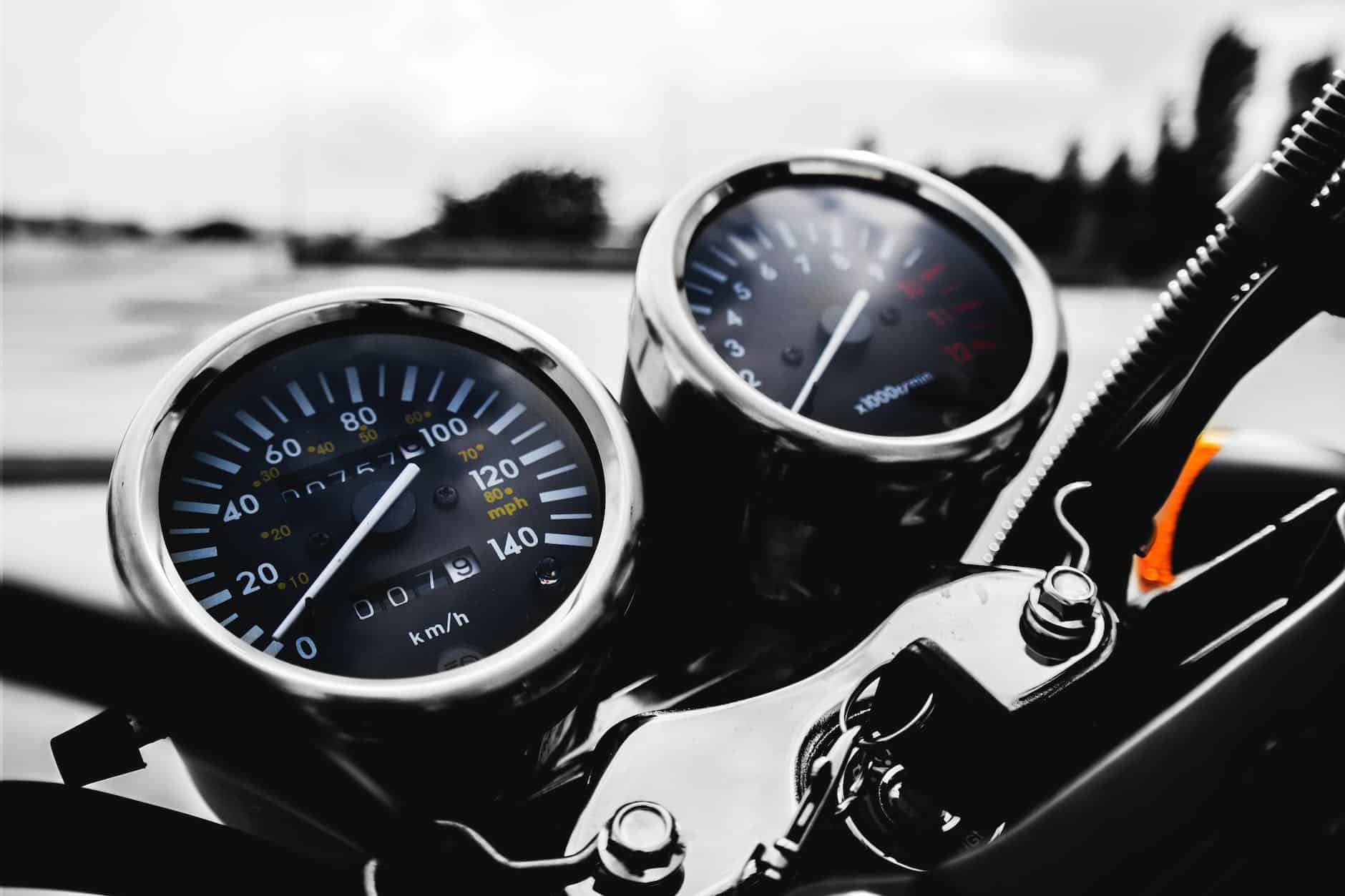Electric motorbikes provide a cleaner, quieter, and more efficient alternative to gasoline bikes. They help reduce urban air pollution, greenhouse gases, and noise, making cities healthier places to live. Thanks to advances in battery and motor technology, they now offer longer ranges, faster charging, and lower operational costs. As industry innovations grow, electric bikes become easier to adopt. To explore how they can transform your commute and contribute to sustainability, discover more below.
Key Takeaways
- Electric motorbikes produce zero tailpipe emissions, significantly reducing urban air pollution and greenhouse gases.
- They operate quietly, decreasing noise pollution and promoting healthier, more peaceful city environments.
- With higher energy efficiency and regenerative braking, electric bikes lower fuel costs and reduce overall operational expenses.
- Supporting renewable energy for charging further minimizes carbon footprint, making them environmentally sustainable.
- Advancements in technology and infrastructure are enhancing affordability, convenience, and adoption of electric motorbikes as eco-friendly alternatives.
The Evolution of Electric Motorbikes

How have electric motorbikes transformed over time? You’ve seen their journey from early battery-powered prototypes in the late 20th century to today’s high-performance models. Battery technology, especially lithium-ion batteries, has played a pivotal role, offering better energy storage and longer ranges. Technological advancements have improved motor efficiency, charging speeds, and overall usability, making electric motorbikes competitive with traditional gas-powered bikes. Features like regenerative braking help extend battery life and boost efficiency. Manufacturers such as Zero, KTM, and Ultraviolette have developed dedicated electric motorcycle platforms, reflecting a shift toward specialized electric vehicle design. Ongoing research and innovation continue to push electric motorcycle development, making these bikes more practical for urban commuting and off-road adventures. The evolution is clear—electric motorbikes are continuously becoming more powerful and accessible, with market trends indicating increasing adoption worldwide. Additionally, improvements in wireless connectivity and control systems are enhancing rider experience and safety.
Environmental Benefits of Electric Motorbikes
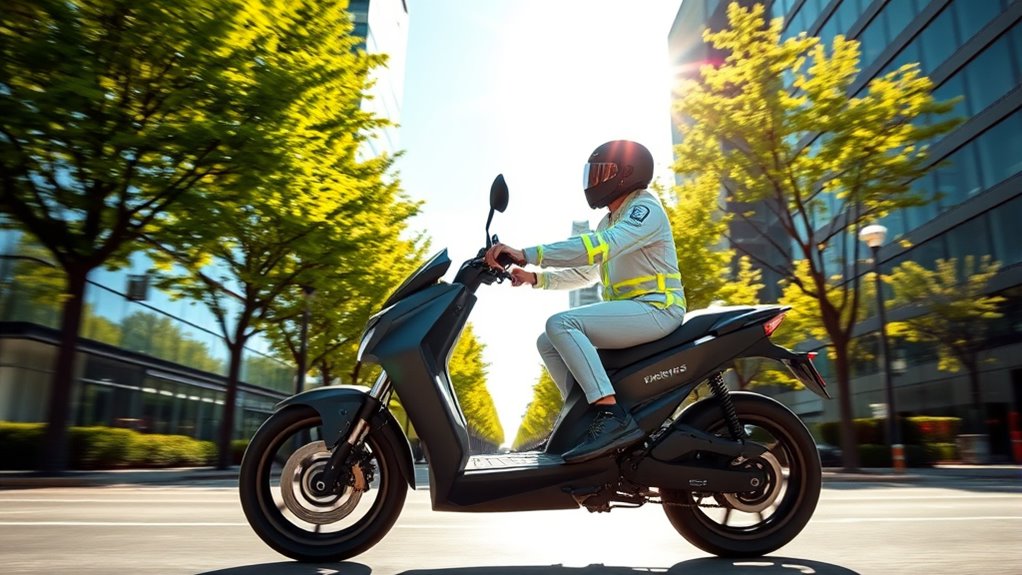
Electric motorbikes produce zero tailpipe emissions, helping cut down on urban air pollution and greenhouse gases. By operating quietly, they also reduce noise in busy city environments. Switching to electric bikes lets you ride cleaner and quieter, benefiting both the planet and your community. Additionally, adopting electric motorbikes supports the shift toward automation in transportation, promoting more sustainable urban mobility solutions. Utilizing electric vehicles also encourages the development of renewable energy sources, further reducing reliance on fossil fuels and lowering overall environmental impact. Furthermore, widespread use of electric motorbikes can inspire advancements in refrigerant management, which is crucial for improving the efficiency and environmental friendliness of electric transportation systems. Embracing these innovations can lead to a more sustainable future with cleaner air and healthier communities. As the industry adopts sustainable fashion practices, it can reduce waste and promote eco-friendly materials in manufacturing electric bikes.
Zero Emission Operation
Electric motorbikes produce no tailpipe emissions, which means they help reduce local air pollution in cities. By choosing electric motorcycles, you engage in zero emission operation, markedly lowering greenhouse gases and pollutants like CO2 and particulate matter. Charging with renewable energy further amplifies these environmental benefits, making your ride part of clean transportation. Over their lifespan, electric bikes emit fewer greenhouse gases compared to gasoline models, reducing their overall environmental impact. Not only do you avoid harmful pollutants during operation, but you also support stricter emission standards like the EU’s Euro 5. To visualize this, consider the table below:
| Aspect | Benefit |
|---|---|
| Zero emission operation | No tailpipe emissions, cleaner air |
| Use of renewable energy | Minimizes carbon footprint |
| Reduced greenhouse gases | Less climate impact |
| Supports clean transportation | Promotes sustainable urban mobility |
Reduced Air Pollution
Switching to electric motorbikes markedly reduces urban air pollution by eliminating tailpipe emissions that contribute to smog and health hazards. Electric motorcycles produce zero emissions, cutting pollutants like NOx, PM2.5, and CO2 considerably. This shift can improve urban air quality and lower respiratory and cardiovascular health risks. To deepen the impact:
- Electric bikes, powered by renewable energy, emit fewer greenhouse gases over their lifespan.
- Cities like Delhi and Mumbai see up to 50% reductions in vehicle-related air pollution.
- Widespread adoption helps lower harmful pollutants, supporting healthier environments and public health.
- Incorporating advanced tuning techniques from Hyundai vehicles can further optimize electric motor performance and efficiency, similar to how Kia Tuning enhances vehicle capabilities.
- Promoting the use of renewable energy sources for charging electric bikes amplifies their environmental benefits and fosters sustainable transportation, especially in regions with high urban pollution levels. Additionally, utilizing energy-efficient charging stations can further decrease overall energy consumption and environmental impact.
Quieter Urban Environments
Because electric motorbikes operate much more quietly than traditional gasoline models, they considerably reduce urban noise levels. With noise levels around 60-70 decibels, electric bikes help lower noise pollution in city environments, making urban areas more peaceful. This quiet operation lessens noise-related stress and hearing health risks for residents and riders. Additionally, reduced noise levels make it easier to comply with city noise regulations and minimize disturbance to wildlife in parks and green spaces. Electric motorbikes are a key part of creating quieter cities, promoting healthier, more comfortable urban environments. Moreover, their environmental benefits contribute to overall urban sustainability efforts. Incorporating electric motorbikes into city transportation strategies can further enhance urban sustainability and support cleaner, greener communities. Being aware of regulatory changes related to electric vehicles can help cities optimize their adoption and benefits. As cities continue to develop sustainable transportation plans, electric motorbikes offer a practical and eco-friendly solution that aligns with lifestyle goals of reducing carbon footprints and improving quality of life.
Comparing Energy Efficiency of Gas and Electric Bikes
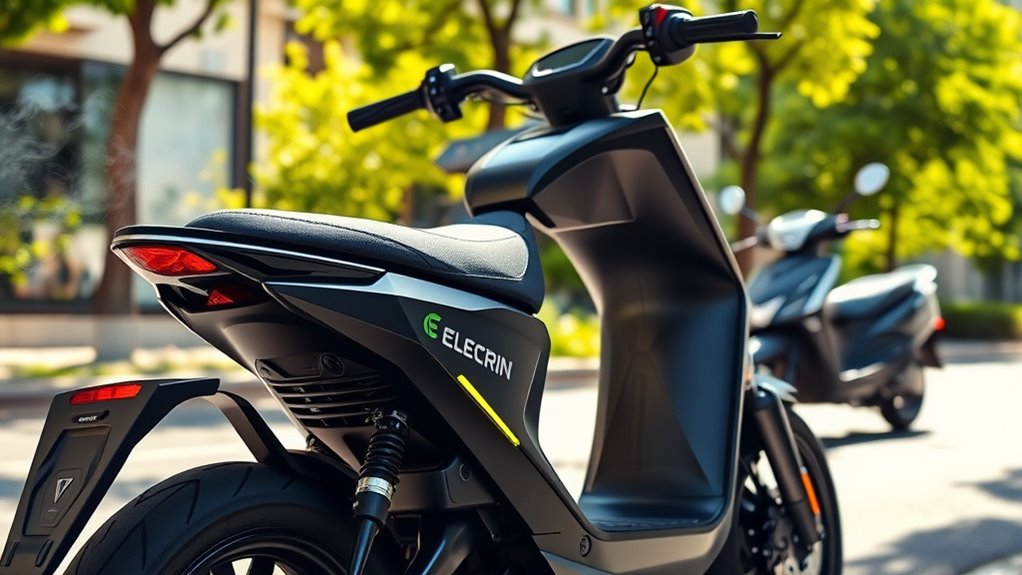
When comparing the energy efficiency of gas and electric bikes, it’s clear that electric motorcycles outperform their gasoline counterparts by a significant margin. Gas bikes convert only 20-30% of fuel energy into motion, while electric bikes achieve 85-90% energy conversion efficiency. Additionally, regenerative braking helps electric bikes recover about 10-15% of energy during deceleration, boosting overall efficiency. Furthermore, the use of high-quality projectors with better light management can enhance the visual experience in home cinema setups, paralleling the importance of efficiency improvements in electric bikes. Studies on energy conservation demonstrate that electric bikes not only reduce fuel consumption but also contribute to lower emissions. Incorporating energy-efficient components can further optimize the performance and sustainability of electric motorcycles. Moreover, ongoing advancements in battery technology continue to improve range and charging speed, making electric bikes an increasingly practical choice. Efficient energy management strategies are essential for maximizing the benefits of electric transportation. To deepen your understanding:
Electric bikes convert 85-90% of energy, far surpassing gas bikes’ 20-30% efficiency.
- Electric bikes minimize fuel consumption, reducing operational costs and environmental impact.
- Their higher energy conversion rates make them more sustainable for transportation.
- Lower energy waste during operation translates into greater efficiency and longer battery life.
This comparison highlights how electric bikes are a smarter choice for sustainable transportation and energy-conscious users.
Cost Savings and Operational Benefits

Electric motorbikes offer substantial cost savings and operational benefits compared to traditional gasoline bikes. With rechargeable batteries, your operational costs drop markedly, as charging typically costs just €0.25-€0.50 per full charge, versus €12-€20 for a 250-300 km fuel refill. Over five years, you could save around ₹1.8 lakh on fuel and maintenance, thanks to fewer moving parts and less mechanical wear. Maintenance is simpler, with no oil changes and fewer engine components, reducing long-term expenses. Additionally, the charging infrastructure is becoming more accessible and convenient, making daily recharges easy. The improved fuel efficiency of electric bikes means you spend less on energy, translating into consistent savings while enjoying a more sustainable ride.
Technological Innovations Driving the Industry
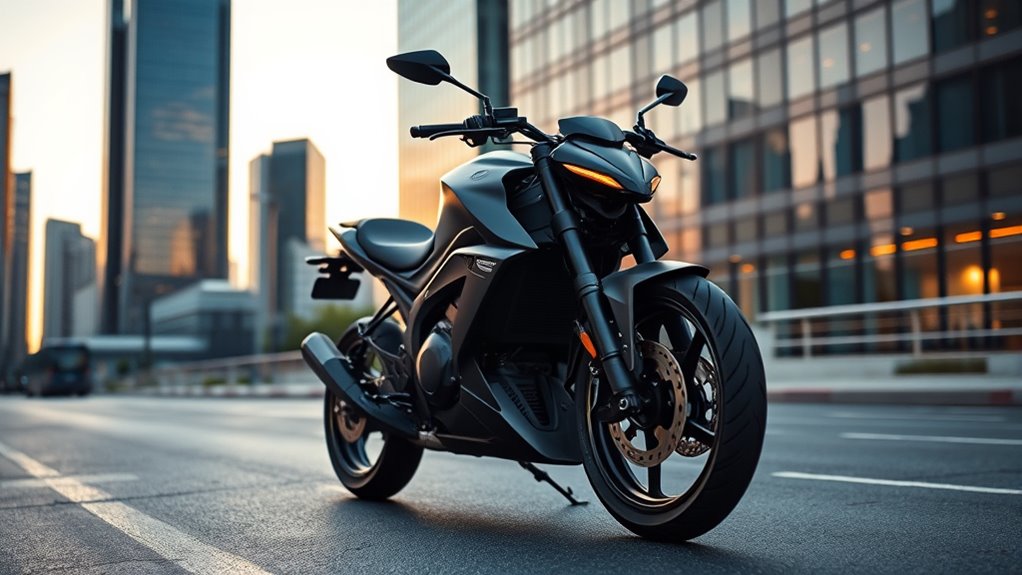
Technological breakthroughs like advanced lithium-ion batteries and rapid-charging systems are transforming electric motorbikes, giving you longer rides with less downtime. Smart connectivity features now let you monitor performance and customize settings on the go, enhancing your riding experience. These innovations are pushing the industry forward, making electric motorbikes more efficient and user-friendly than ever before.
Battery Technology Breakthroughs
Recent breakthroughs in battery technology are transforming the electric motorcycle industry by boosting range, safety, and convenience. Advances in lithium-ion batteries have increased energy density, allowing you to ride over 200 km on a single charge. Solid-state batteries are emerging as a safer alternative, offering faster charging and longer lifespan. Modern battery management systems optimize charging cycles, extending battery life and improving efficiency. Additionally, the development of fast-charging infrastructure can deliver 80% charge in under 30 minutes, reducing waiting times. Removable batteries and modular designs make maintenance easier, enabling quick swaps and reducing downtime. These innovations empower you to enjoy longer rides with enhanced safety and convenience, making electric motorbikes a more practical and sustainable choice.
Rapid Charging Solutions
Have you noticed how quickly rapid charging stations are appearing in cities and along highways? These fast-charging stations are transforming electric mobility by drastically reducing charging times. Thanks to rapid charging technology, your electric motorcycle’s battery can reach 80% capacity in just 30 to 60 minutes, minimizing downtime. Advances in infrastructure, like CCS and CHAdeMO standards, make it easier to find quick-charging options both urban and highway-side. High-capacity ultra-fast chargers, exceeding 150 kW, enable faster recharging than traditional fuel stops. Innovative battery management systems help extend your battery’s lifespan while supporting these rapid charge cycles. Portable and modular stations further enhance flexibility, allowing you to recharge on the go and expanding access in remote or underserved areas.
Smart Connectivity Features
Smart connectivity features are transforming how you interact with your electric motorcycle, making rides safer and more convenient. With advanced connectivity, you can access real-time battery monitoring, range estimation, and maintenance alerts, helping you maximize efficiency and battery life. The digital dashboard displays essential ride statistics, while mobile app controls let you manage security, navigation, and riding modes remotely. These smart features enhance urban mobility by integrating your bike with smart home systems and IoT devices, creating a seamless connected experience.
Consider these key innovations:
- GPS tracking and anti-theft alerts for security
- Wireless software updates to improve performance
- Integration with digital dashboards and smartphone apps for navigation and ride data
Challenges and Barriers to Adoption
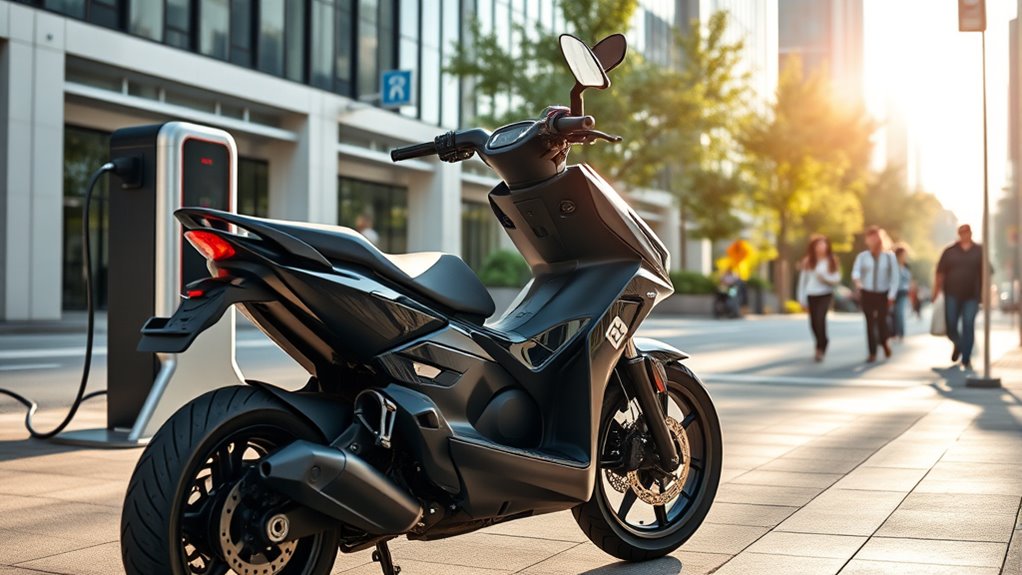
Despite the growing interest in electric motorbikes, several significant barriers hinder their widespread adoption. Limited charging infrastructure means you might struggle to find convenient places to recharge, and long charging times—up to 3 hours—can be inconvenient. Higher initial purchase costs, often between ₹1.5–3 lakh, make it harder for many to afford one. The limited range of affordable models, around 35-50 km per charge, increases range anxiety, discouraging longer trips. Additionally, many consumers lack confidence in electric motorcycle technology due to limited awareness and familiarity. Insufficient government incentives and inconsistent policies further slow down adoption. Overcoming these barriers requires improving charging infrastructure, offering better incentives, reducing costs, and building consumer trust in electric motorcycle capabilities.
Impact on Urban Mobility and Air Quality
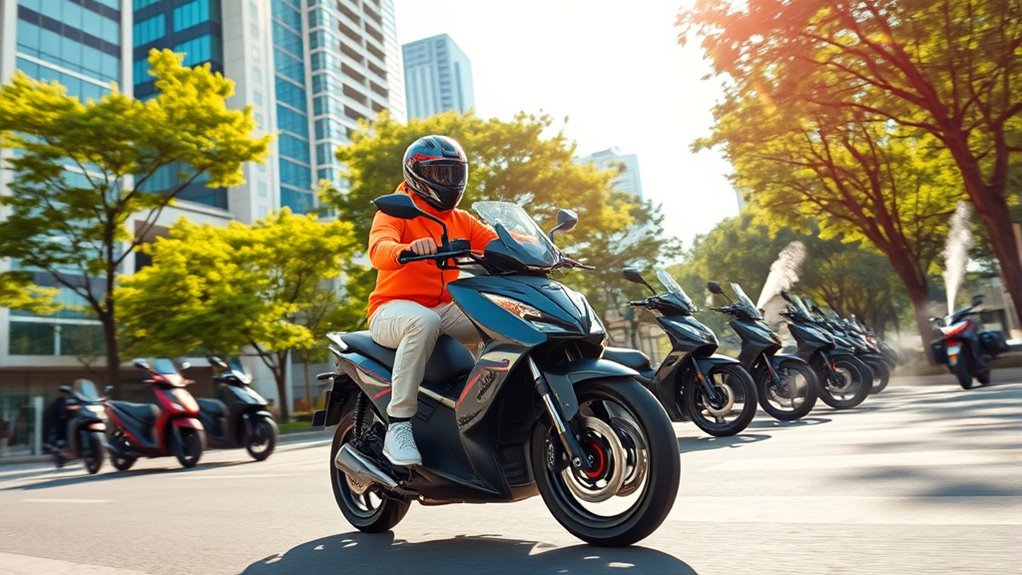
Electric motorbikes are transforming urban mobility by offering a cleaner and more efficient alternative to traditional gasoline-powered vehicles. They help improve air quality by producing zero tailpipe emissions, reducing pollutants like NOx and PM2.5 that cause smog and respiratory issues. Their compact size and maneuverability help ease congestion, making city travel smoother. Additionally, electric motorcycles operate quietly, drastically cutting noise pollution in busy urban areas.
To deepen your understanding:
- Electric bikes support compliance with stricter pollution standards like Euro 5, enhancing air quality.
- The reduction in emissions from electric motorcycles contributes to climate goals and lowers greenhouse gases.
- Improved urban mobility through electric bikes fosters healthier, quieter, and more sustainable city environments.
Future Trends and Industry Developments
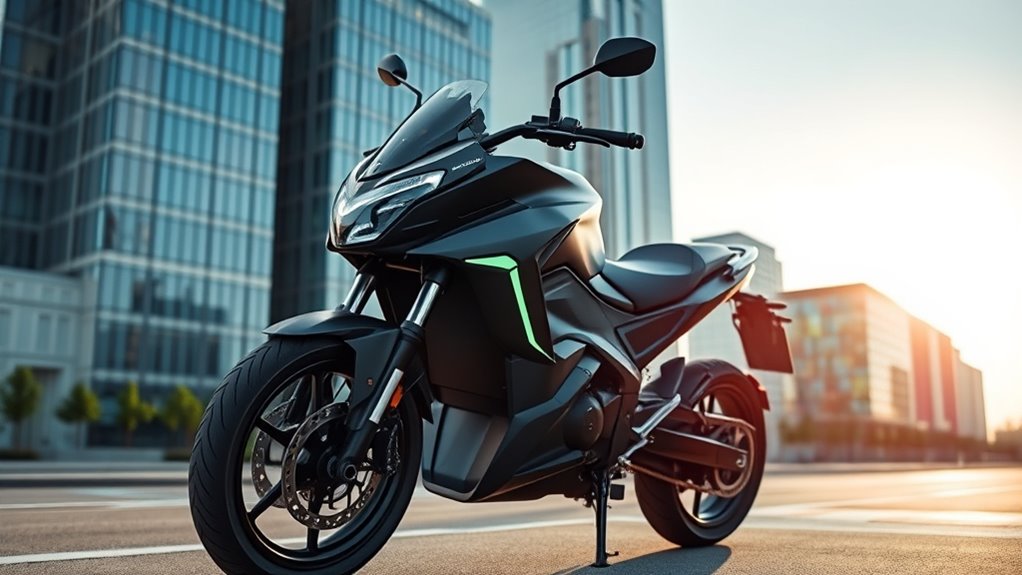
The electric motorcycle industry is poised for rapid growth, with projections indicating a compound annual growth rate of over 20% through 2030. Industry developments are driven by technological advancements like high-performance models, fast-charging capabilities, and smart connectivity. As manufacturers invest heavily, innovations such as removable batteries and regenerative braking become standard, enhancing user experience. Expanding charging infrastructure supports this growth, making electric motorcycles more practical for daily use. Market share is expected to surpass 30% in regions like Europe and North America, reflecting a shift toward sustainable mobility solutions. The table below highlights key industry trends:
| Trend | Impact |
|---|---|
| Technological Advancements | Improved range and performance |
| Charging Infrastructure | Increased accessibility |
| Market Growth | Broader adoption |
| Industry Developments | Stricter emissions standards |
| Sustainable Mobility | Reduced carbon footprint |
How to Choose the Right Electric Motorbike

Choosing the right electric motorbike involves evaluating your specific riding needs and preferences. To find the best fit, consider these key factors:
- Range: Opt for models with at least 80-100 km of range to cover daily commuting and off-road adventures comfortably.
- Performance: Look at motor power and torque—higher torque (like 90 Nm in the Ultraviolette F77) ensures quick acceleration and responsiveness.
- Features: Check for fast-charging capabilities that can recharge to 80% in under 2 hours, and explore comfort, connectivity, and safety features to enhance your riding experience.
Balancing these elements will help you select an electric motorcycle that matches your lifestyle and riding style efficiently.
Frequently Asked Questions
Are Electric Motorcycles Environmentally Friendly?
When you ask if electric motorcycles are environmentally friendly, you’re considering their impact on our planet. You might be surprised to learn that they produce zero tailpipe emissions, helping improve air quality. Plus, over their lifespan, they emit fewer greenhouse gases, especially if charged with renewable energy. While manufacturing has some environmental costs, overall, you can feel good knowing that choosing electric bikes supports a cleaner, greener future.
Are Electric Motorcycles Better Than Gas Motorcycles?
So, you’re wondering if electric motorcycles are better than gas ones? Well, imagine riding a machine that’s cleaner, more efficient, and cheaper to run—no fumes, no fuss. You get instant torque, smooth acceleration, and save money long-term. Plus, you’re helping the planet without sacrificing speed or fun. Honestly, it’s like upgrading from a noisy, polluting dinosaur to a sleek, eco-friendly rocket. Why settle for less?
What Is the Lifespan of an Electric Motorcycle?
You’re wondering about the lifespan of an electric motorcycle. Typically, it lasts between 8 to 15 years, depending on how well you maintain it and the quality of the components. The battery, a key part, usually retains 70-80% capacity after several thousand charge cycles. Proper care, regular maintenance, and advancements in technology can help extend its lifespan, ensuring you get years of reliable riding.
What Is the Most Eco-Friendly Motorcycle?
Imagine riding a whisper of wind—light, clean, and kind to the Earth. You’re looking for the most eco-friendly motorcycle, and electric bikes are your best bet. They produce no tailpipe emissions, convert energy efficiently, and, with renewable charging, shrink your carbon footprint. While manufacturing has some impact, their overall sustainability shines, especially over long distances. So, you can enjoy the thrill of the ride while caring for our planet.
Conclusion
Choosing an electric motorbike means embracing innovation, reducing emissions, and transforming your daily commute. It’s about powering your ride with cleaner energy, enjoying quieter journeys, and contributing to a healthier planet. It’s about moving forward with confidence, riding toward sustainability, and leaving behind the fumes of the past. Embrace the future, ride with purpose, and let your journey be a statement of change—one electric mile at a time.
